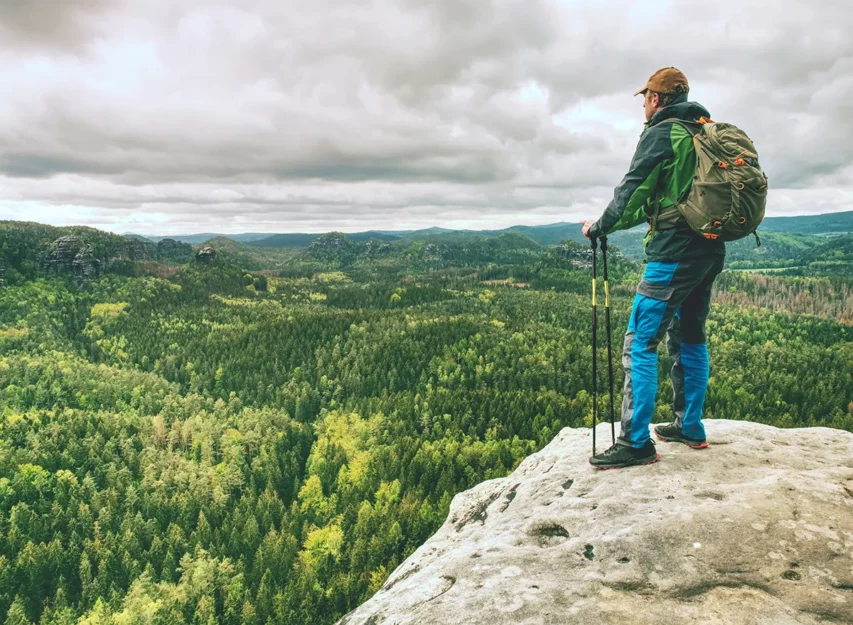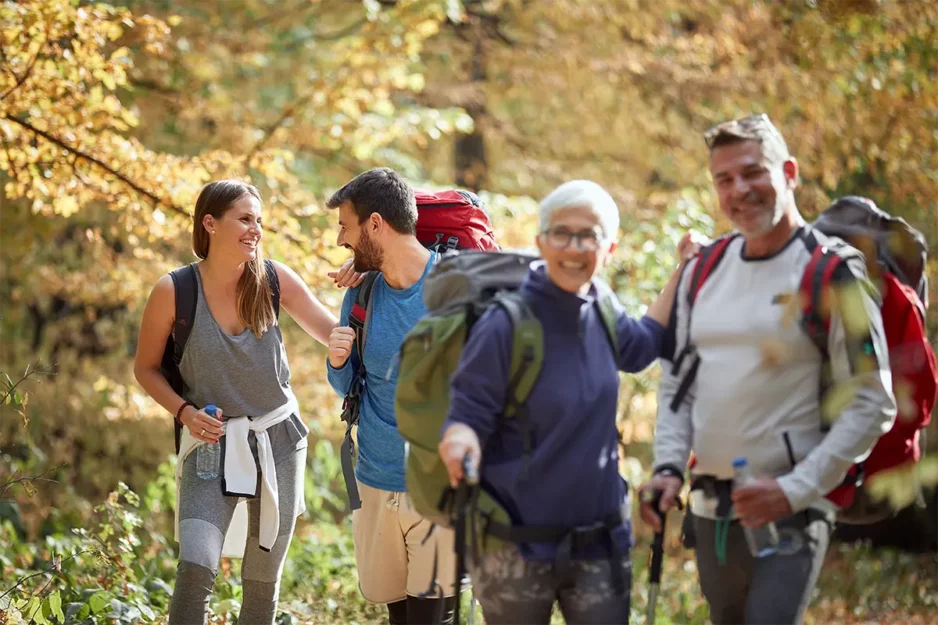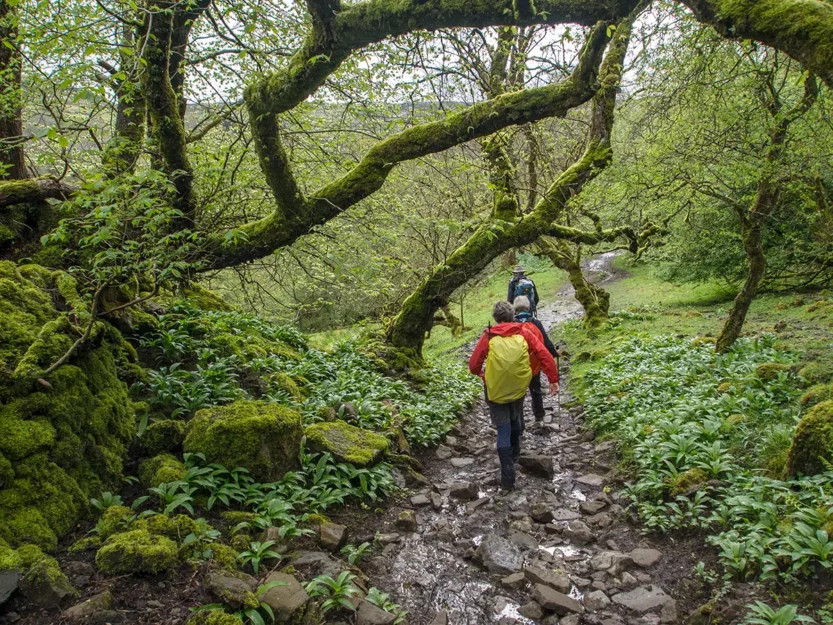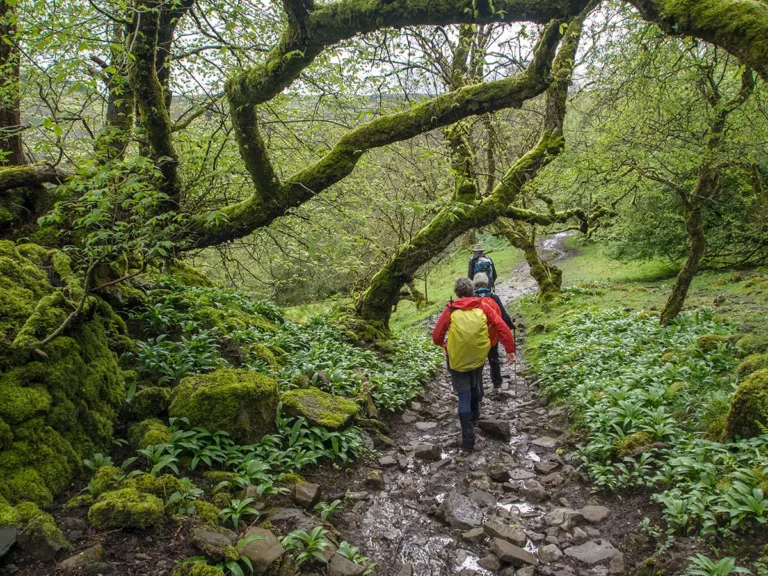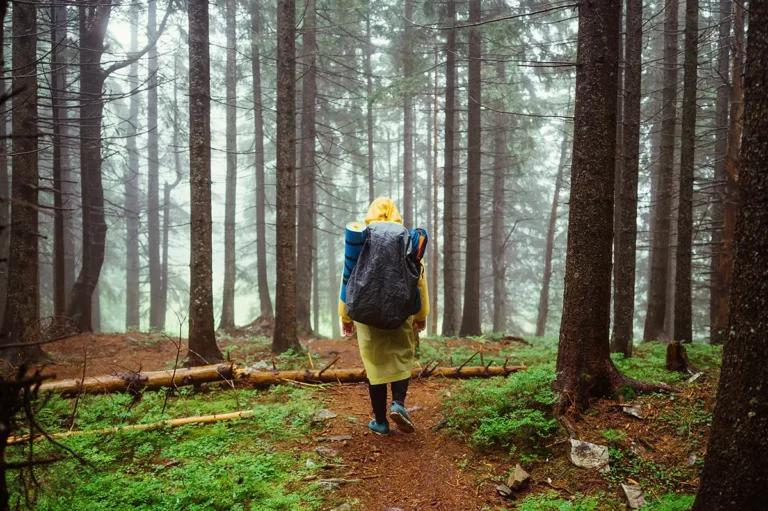If you’re confident hiking in mud and across slippery rocks, then hiking after rain is a fun way to re-explore old trails and enjoy the post-rain beauty of others.
However, just like hiking in the rain, going for a hike after it rains comes with new obstacles and risks.
This article breaks down the gear you need to stay dry with advice and safety tips for navigating wet trails.
- The dangers of hiking after rain. There’s more to consider than slips and falls, like flash flooding and landslides.
- What to wear on hikes after the rain. Always be prepared for the current weather conditions and the chance of rain returning.
- Trail conditions: Is the trail open after rain? It’s common to see trail closures caused by certain dangerous or destructive conditions.
- Tips for hiking after rain. Stormy conditions demands stricter self-evaluation.

How to safely hike after rain
The rain finally stopped, and the sun peaked through the clouds. But is it actually safe to hit the trail?
Slips and falls are the most common concern after the rain, but spending time in the wilderness brings a lot of unexpectedness, and you never want to be surprised by nature.
The dangers of hiking after rain
When I think about rain and dangerous hikes, the Narrows at Zion National Park always comes to mind. This famous slot canyon leads hikers wading shin to waist-high in the Virgin River. On each side are 1,500-foot sheer rock walls.
The terrifying aspect of this trail is a storm at the park isn’t your biggest concern. Heavy rain hitting the tributary 20 miles north can send rushing water through the canyon hours after the rain subsides.
Flash flooding and swelling creeks
The dangers of storms don’t end when the last drop falls. A raging storm away from your sightline can still feed rivers and creeks, washing out trails and sweeping hikers away.
In Las Vegas, where I’ve lived and hiked for over three decades, monsoon season brings dangerous flash floods across the valley. Even heavy rain at the dryest place on earth, Death Valley, trapped over 1,000 visitors flooding cars and destroying roads.
Always research your hike and the surrounding area for flash flood warnings or any history of flash flooding.
Landslides and avalanches
Heavy rain disturbs the natural stability of land and snow, risking dangerous landslides and avalanches. Avalanches are responsible for more than 150 deaths annually, while landslides average nearly 1,000 deaths worldwide.
According to the CDC, areas at high risk of landslides or mudslides include:
- Areas affected by wildfires
- Areas of modified land with destroyed vegetation
- Areas below canyons or steep slopes
- Channels along a river or stream
- Areas below a surface runoff
- Areas prone to landslides
Slippery trails and rocks
Ankle injuries account for 42% of all hiking injuries. Trauma to the head follows behind it with 13%. When you add a muddy trail and slippery rocks, the risk of injury grows, especially when descending.
Take it slow, choosing your steps carefully.
Using trekking poles helps to reduce the risk of injury. If you opt out of poles, wear a backpack to keep your hands free to catch you if you slip. Packs can also help to soften a fall on your back.
Lightning
If you’ve ever been too close to a lightning strike, the distinct crackling sound sends chills down your spine just thinking about it.
Annually, lightning strikes the ground over 40 million times in the United States. It causes roughly 20 deaths and hundreds of injuries. On high-elevation hikes, passing the tree line turns hikers into the tallest and easiest target.
A lightning bolt can also travel 12 miles from a thunderstorm. This means it may be out of sight if you’re hiking in a valley or canyon.
Unpredictable weather
Isn’t all weather unpredictable? I often check the Apple weather app for precipitation, and the forecasting is somewhat reliable. Still, I wouldn’t trust my life on it.
Relying on your eyes and intuition is vital when hiking after rain. If you see a storm rolling in, a decision needs to be made if you should return or push forward. Always trust your gut. Hikers are wired to push on, but it’s not always the safe answer.



What to wear on hikes after the rain
Preparedness is everything in hiking. And just because you call it ‘after the rain’ doesn’t mean the rain can’t return. Dress as if it will.
Essential gear for hiking after rain:
- Waterproof hiking boots. A wet hike requires the proper footwear; this means no tennis shoes. Wear a hiking boot that holds a grip on slick rocks and keeps your feet dry from mud and standing water.
- Rain poncho or waterproof jacket. Depending on the season, pack a rain poncho or light jacket. You need to be prepared if the rain returns.
- Waterproof backpack or rain cover. Be sure your backpack is waterproof, or use a rain cover to keep it protected. A soaking-wet backpack weighs you down and won’t protect items inside.
Additional wet-weather gear to consider:
- Trekking poles. Using trekking poles helps to reduce your reliance on grip, which is especially important when descending steep hills or creek crossings.
- Emergency bivvy. Hiking after rain risks becoming trapped by surging creeks and rivers swallowing the trail. An emergency bivvy can be life-saving if you must hunker down for hours or through the night.
Cotton should always be avoided for physical activity, especially if there’s a risk of becoming wet. Since cotton is an absorbent material, it traps moisture, becoming heavier and preventing the body from evaporative cooling.
That goes for denim cotton, too, so avoid wearing jeans on hikes.
Trail conditions: Is the trail open after rain?
Due to risks to yourself and the trail, it’s common for the National Park Rangers to close trails. Although there are over 14,000 park rangers, they can’t be everywhere, so closures aren’t always evident.
Unfortunately, a blockade at the parking lot or a sign at the start of the trail might be an unwelcome surprise. Check online first for posted rules. You can also call the ranger station to confirm.
Most trail closures are due to concerns about trail hazards, such as:
Trail deterioration
A trail along the side of a hill or mountain risks deterioration when wet, a dangerous and destructive issue. This forces some trails to close during bad weather.
Rain-swollen creeks
Avoid trails near creeks or rivers when hiking after rain. It can take hours for rainwater at a tributary to swell a creek miles away. In that case, your hike back might find the slow-flowing creek is now a waist-high rapid.
Always avoid crossing fast-moving water. If the safest option is attempting to cross, release your backpack straps first so you can ditch the bag and not be pulled along with it.
Flash flooding
Flash flooding happens when heavy rainfall exceeds the ground’s absorption ability. When water has nowhere to go, it rushes to lower areas.
In 2021, a year that saw a surge in new hikers, eight hikers were killed in floods. Always check for weather warnings when researching your hike.

Tips for hiking after rain
The trees, grasses, birds, everything is more lively after the rain. Even the air has a unique crispness with that fresh, calming rain smell.
Hiking after rain also delivers a new feel and challenge to a familiar trail. But with the reward comes more risk, one that demands an elevated level of awareness and preparedness, such as:
- Self-evaluation. Weather rarely cooperates, and when it doesn’t, knowing it’s time to hike out is essential. As hikers, we’re used to powering through to get to the summit, our finish line. But when hiking after rain, the finish line is simply making it home safe.
- Packing extra dry clothing. Pack dry socks, pants, and a shirt for the drive home. You never know how much mud or water you’ll face until you’re already on the trail.
- Continuously monitoring the weather. Most smartphone weather apps can show precipitation maps; the challenging part will be finding cell service. You’ll need to trust your eyes and instincts on the trail.
Final thoughts
The benefits of hiking after rain can certainly outweigh the risks. Trails are less crowded, making popular viewpoints accessible and quiet. The scenery is more beautiful. And the air is cleaner.
Even the smell of rain, called petrichor, is known to have a calming effect.
If you’re confident in your footing and familiar with the trail and surrounding area, hiking after rain can be a memorable and safe adventure.
Check your local weather, research your trail, prepare your gear, and hike safely.
Did you decide to go for a hike after the next rainstorm? Share this article with friends and family to inspire others. They may even join you.


